2012 digital camera holiday gift guide
This 2012 digital camera holiday gift guide looks at the best cameras in the $2000+ price range. These cameras are for dedicated enthusiasts and professionals, those who need full manual and creative control, with the ability to swap out a variety of zoom and prime lenses. These cameras often have full frame 35mm image sensors, and are increasingly used to capture beautiful time lapses as well as independent feature film and television series.
So, let’s jump into our 2012 Holiday gift guide and see what you get in the $2000+ digital camera range. Our following recommendations are based on quality, features and the best value available on the digital camera marketplace above $2000 dollars (MSRP).
Top pick: Sony DSC-RX1 (our preview | best price)
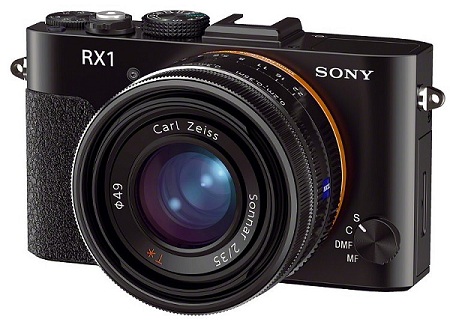
Sony has unveiled a game changer in the Prosumer camera niche with the most powerful non-interchangeable lens point-n-shoot to ever to grace the face of the earth; the new Cyber-Shot DSC-RX1, the world’s first ever compact point-n-shoot to offer a full-frame (35mm) Exmor CMOS image sensor! That’s right, I said Full-Frame. The RX1 is packed with the same 24.3-megapixel Exmor CMOS image sensor that Sony redesigned for use in their a99and NEX-VG900 cameras; along with the same new BIONZ image processor. This sensor peers through an all new fixed 35mm lens, which Sony claims is the highest quality lens to ever grace the Cyber-Shot line. The Carl Zeiss Sonnar T* f/2.0 35mm lens promises extreme clarity, along with amazing background defocus (aka bokeh) thanks to its wide open aperture options and 9-blade circular aperture.
It’s all about size, speed, and quality with this camera; and they’ve aimed the RX1 squarely at professional photographers and enthusiasts who want the versatility and quality of a full-frame sensor packed into a compact camera that they can carry around much easier than their bulky dSLR. Pick up the RX1 if you want unparalleled image quality in a compact point-and-shoot and don’t mind the lack of an interchangeable lens.
Canon EOS-1D X (our preview | best price)
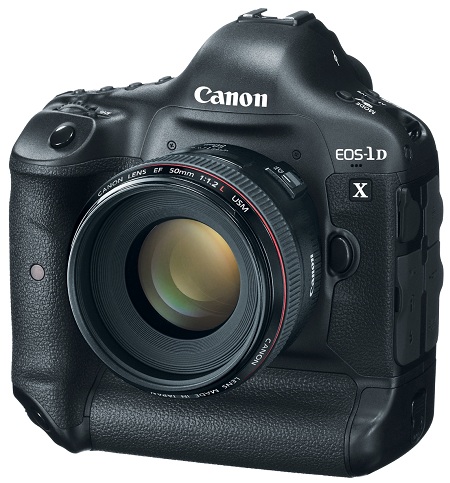
Canon has just announced their most advanced camera to date, the EOS-1D X. The X label represents two distinct aspects of this camera; one, it’s the 10th generation of Canon’s Pro EOS SLRs, two it’s one eXtreme camera. Canon has taken the strengths of the 1Ds Mark II and 1D Mark IV, and stuffed them into one complete powerhouse, which boasts a full frame 18-megapixel CMOS image sensor, Dual DIGIC 5+ image processors, up to 12fps burst shooting at full resolution or 14fps with no AF, a third DIGIC 4 processor specifically for handling the information from an all new 100,000 pixel RGB metering sensor (107, 250 effective pixels), and much more. These features combined make the 1D X the ultimate professional dSLR, which will cater to the needs of most any photographer; whether you’re shooting Monday night football, or the latest fashion event.
Other appealing features that pros are sure to love are dual CF card slots, built-in gigabit Ethernet and USB 3.0 ports, two stops lower noise compared to past EOS models, ISO range from ISO 50 – 204,800 with expansion enabled, 2nd generation self cleaning system, new shutter rated up to 400,000 cycles with carbon fiber shutter blades and new drive system, improved intelligent OVF, increased durability, new control layout, a 3.2-inch LCD with over 1 million dots, an all new 61-point phase detection AF system, updated video options with new compression formats and much, much more. Pick up the 1D X if you’re a Canon fan and want the best of the best.
Sony SLT-A99 (our preview) | best price)
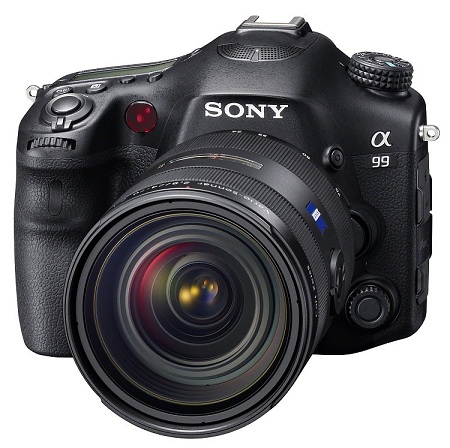
The most powerful dSLR Sony has created to date; the SLT-A99 is packed with their latest technologies, including a new 24.3-megapixel full-frame Exmor CMOS image sensor. The full-frame sensor gives you a true 35mm field of view when using either Sony or Minolta A bayonet glass, along with greater control over depth of field, increased bokeh, etc. They claim this sensor, “realizes high resolution, wide dynamic range, and high ISO sensitivity for corner-to-corner high-quality images.” The standard sensitivity range is from 100 – 25,600 (expandable to ISO 50), and this new unit boasts three new sensor technologies. First, Light connection technology features a thinner wiring layer and on-chip lens color filter to help increase light efficiency, while Photodiode expansion technology allows for expanded receptor surface area. The sensor also boasts a new multi-segment optical low-pass filter; all of which further enhances the a99’s ability to create beautiful, high-resolution images. On top of a new sensor, the a99 received an improved BIONZ processing engine to help the camera quickly digest the massive amount of information coming from the 24-megapixel full-frame image sensor. This processor offers a new high-speed front-end LSI to help speed up processing, 14-bit RAW output (8-bit JPEG), and area-specific noise reduction options. The shutter life has been raised to 200,000 cycles, and burst shooting can be realized at 6fps with continuous/tracking AF, or up to 10fps with single AF – both at full resolution.
Another huge upgrade on the a99 is the world’s first Dual AF system, boasting two separate Phase Detection AF sensors – a 19-point (11 cross points) precision AF sensor combined with a 102-point Focal Plane Phase AF sensor; for a combined 121 active focus points. Sony claims this level of AF performance is only made possible thanks to their Translucent Mirror Technology. With this new system, Sony has added two new AF functions; AF-D Mode and AF Range Control. AF-D Mode is an advanced continuous AF mode that uses the 102 focal place assist area points to create a depth map to track subjects, while the precision 19-point AF sensors dial in crisp focus. AF range control allows you to set the range in which the AF system can operate, allowing you to reduce front and back focusing due to interference from objects in the foreground or background. Pick up the A99 if you want the best dSLR Sony has to offer.
Nikon D600 (our preview | best price)
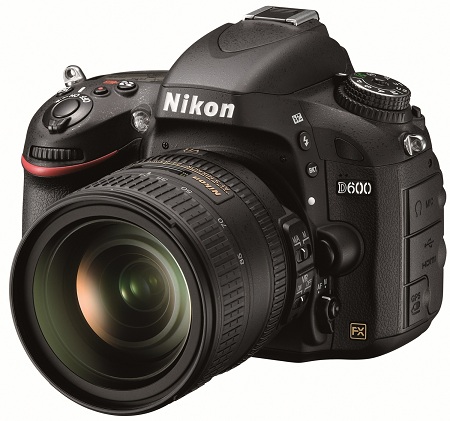
A 24.3 megapixel FX-format (full frame) CMOS sensor paired with a EXPEED 3 image processor, the Nikon D600 ready to shoot in 0.13 seconds. There’s also a 39 point AF (Auto Focus) MultiCAM 4800FX AF Module, which runs even during the 5.5 frames-per-second high speed burst shooting. Full 1080p HD video is a given — here at 24p, 25p and 30p — but there’s also an option to shoot 720p at up to 60 frames per second. Still images and video record to dual SD card slots, to improve productivity, and you can even review footage via 3.2-inc LCD display or on an HDTV via the HDMI output, which also allows you to transfer uncompressed HD to a digital recorder. Nikon’s Scene Recognition System uses a 2,016 pixel RGB sensor to pick optional shooting settings in any location. And there’s even some creative Scene Modes, including HDR, from which to choose. The D600 includes magnesium alloy top and rear construction with loads of rubber seals to keep out moisture and dirt. The shutter is rated for 150,000 cycles and a full battery charge should get you up to 900 shots. Pick up the D600 if you want one of the most affordable full-frame dSLRs on the market.
Canon EOS 6D (our preview | best price)
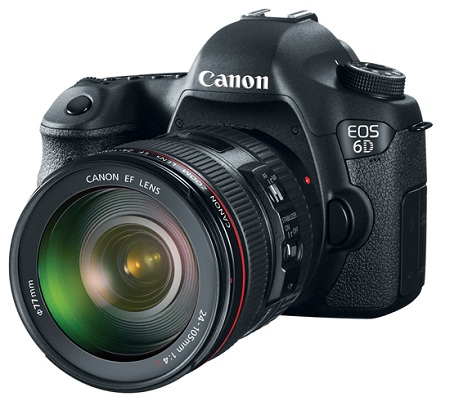
Potentially the smallest full-frame dSLR on the camera market, the EOS 6D utilizes Canon’s DIGIC 5+ Image Processor and offers a 20.2-megapixel full-frame CMOS sensor. In addition, the 6D offers a 3.0-inch, 1.04 million dot LCD display with a viewing angle of 170 degrees. Interestingly, the Canon EOS 6D includes built-in Wi-Fi using a wireless transmitter within the camera. When connected to Wi-Fi, the 6D can transmit photos and video to social networking sites like Facebook or devices like smartphones and laptops. In addition, media can be transmitted between compatible PowerShot cameras. Another wireless function allows the camera to be controlled through an application on a tablet or smartphone, ideal for taking photos remotely.
GPS functions are also directly built into the 6D rather than requiring an add-on, external device. The built-in GPS receiver records longitude, latitude and elevation as well as EXIF data for geo-tagging while shooting. When photos are uploaded to social networks, the location data can be included to mark the spot where the photo was originally taken. Regarding video recording, the 6D can record in both NTSC and PAL video modes at 1080p, 720p or standard resolution. ISO capabilities range from 100-25600 and the Canon Auto Focus system includes a newly-developed 11-point AF sensor. Moving away from Compact Flash, the Canon 6D is compatible with SD, SDHC, and SDXC memory cards as well as Ultra High Speed (UHS-I) cards. Pick up the 6D if you want a stellar image with all the latest tech upgrades.
Nikon D4 (our preview | best price)
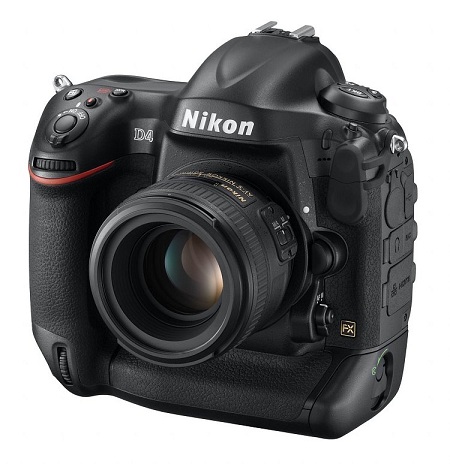
Nikon’s flagship dSLR, the D4, oozes with professional class features that multimedia photographers need and demand. Nikon claims that this camera has been “designed to emphasize rapid response and seamless operation to help professional photographers consistently capture incredible content.”, and from looking over the specifications, we can see how they can make such claims. The D4 boasts a full-frame, FX-format, 16-megapixel CMOS image sensor, which is mated to their EXPEED 3 processing system. To help aid in fast autofocus, Nikon has included an upgraded version of their already proven 51-point phase detection AF system in the D4, which they claim offers unparalleled speed and accuracy; even when taking advantage of the D4’s 10fps burst mode capabilities (at full resolution with AF / AE, or 11fps with AF / AE locked). The Multi-Cam 3500 AF system is also fully customizable, giving Pros the opportunity to set up the D4 specifically for their needs. Other impressive features include a 91,000 pixel 3D Matrix Metering III sensor, ISO sensitivity from ISO 50 – 204,800 (with expansion enabled), Full HD video at 1080p (60p, 30p or 24p), in-camera HDR, Active D-Lighting, Dual CF card slots (compatible with new XQD cards), direct streaming of uncompressed full HD signal directly out of the camera using HDMI output, a 3.2-inch LCD with 921k dots, Advanced SRS (Face Detection and Scene Analysis), a tough body and chassis (resists moisture, dust, and even electromagnetic interference), and much more. Pick up the D4 if you want the best Nikon has to offer in 2012.
Need to know what camera to buy this holiday season? We can help! We have holiday gift guides for the 2012 shopping season for every price range and type of photographer.




March 29, 2017 at 2:41 am, moore54623 said:
nuclear science have a great appearance in the world. You explain correctly that there have no higher degree engineer in it. So i think we need to study more about this energy.